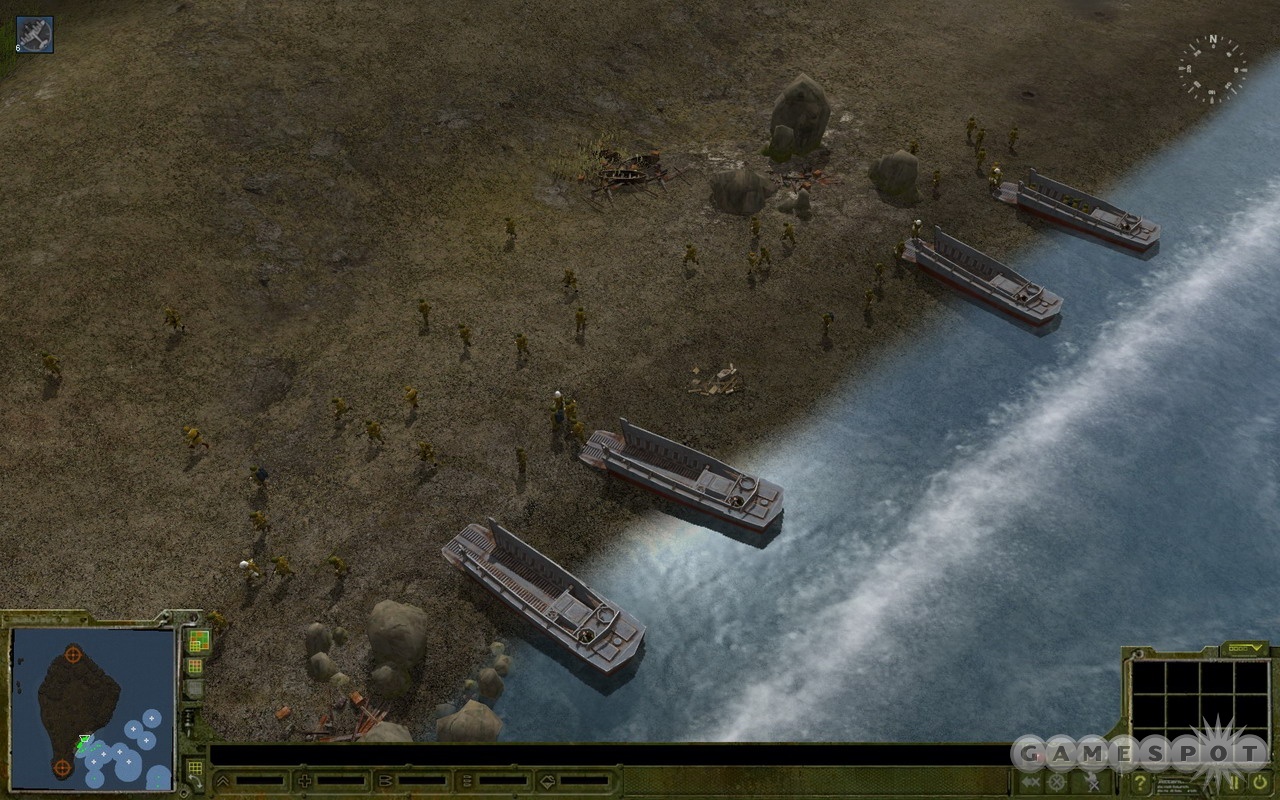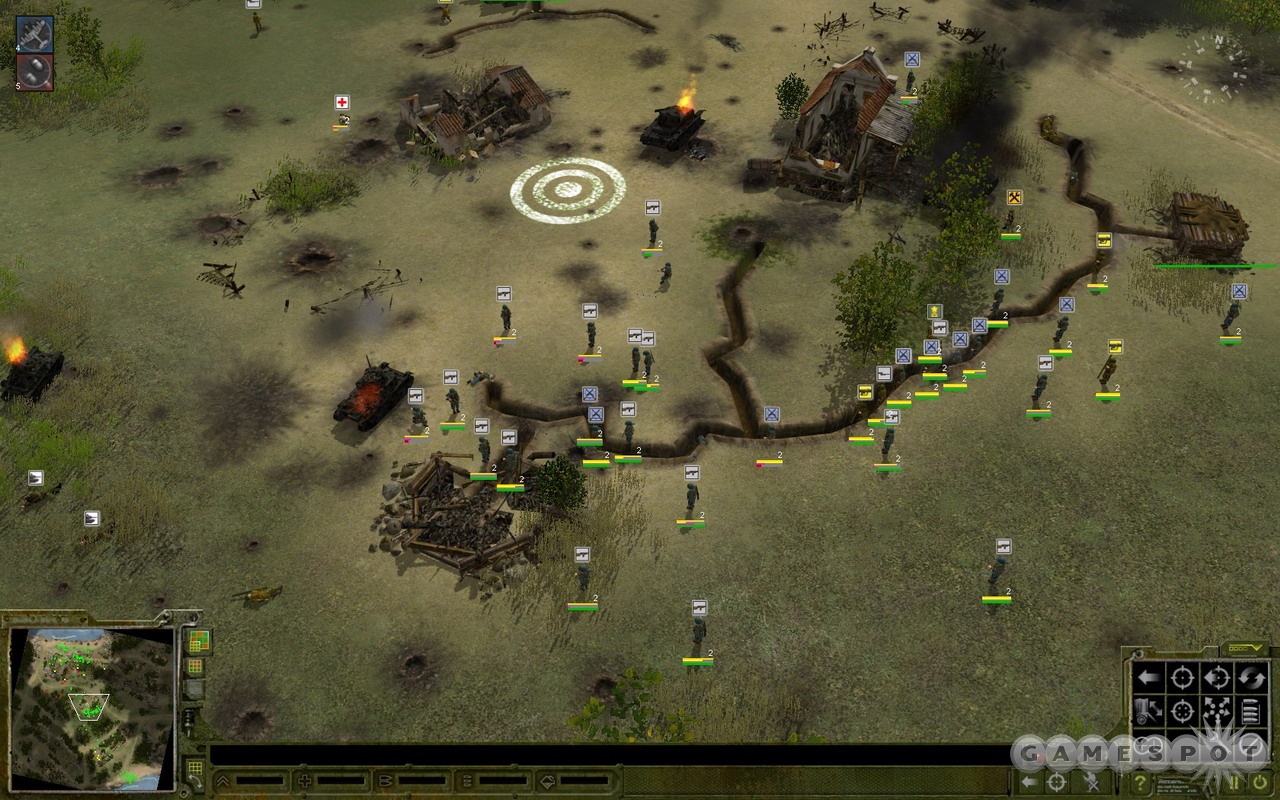For a game franchise nudging the two million mark in total sales, Sudden Strike doesn't get a whole lot of respect. But the latest addition to the family might just turn things around, thanks to new epic-scale battles and an intensity unmatched by its predecessors. Sudden Strike 3: Arms for Victory remains a long way from tactically minded World War II real-time strategy perfection, and it needs some serious battlefield refinements before entering the big leagues, but this is still the best game in the history of the series.

Scale is what really differentiates Arms for Victory from the first two games in the series and their expansion packs. Whereas the WWII battlefields re-created in the earlier games could be conquered in no more than a couple of hours, the scenarios here are absolutely massive. You still don't have to worry about any base-building, given that gameplay is a straight-up tactical blitz of ordering around troops and tanks as well as calling in artillery fire and bombing runs. But each of the campaign missions and the one-off custom scenarios depict hundreds of square miles of terrain occupied by hundreds if not thousands of troops, tanks, trucks, and artillery, making for lengthy, amazingly intense battles that can take full evenings of play to finish.
Battles now consist of multiple stages that take you from the initial moments of an assault through numerous objectives, such as taking out German artillery on D-Day, helping the British at Sicily, and helping the Russians steal from German supply depots before demolishing a train yard. Terrain features are also realistically modeled. Instead of blitzing from one end of a map to the other, you now have to take into account geographical complications. Maps are gorgeous, with intricately modeled trees, muddy turf, murky swamps, and so forth, but the real impact is on tactical considerations. Enemies can hold the high ground on hills, necessitating a tough decision on whether to head up with a frontal assault or try to go around them. Artillery buried in a forest can force you to consider an armor attack or one of those precious, limited air strikes (which may not even be a sensible option if the enemy still has AA guns in operation). And swamps can stop an advance dead in its tracks; the muck bogs down tanks and heavy vehicles so much that you have to send troops across the terrain on foot.
This is a much more complex, strategically demanding game than previous Sudden Strikes. Unlike in earlier games in the series, which leaned on straightforward tank rushes against insane levels of enemy opposition, here the battlefield seems more level. Whereas before it seemed like the game was cheating by throwing spectacular numbers of enemies at you, now you seem to have a fair shot of winning against reasonable numbers of bad guys, at least as long as you think ahead. Long-term planning is a must on every map because you need to take into account troop strength and terrain obstacles before committing any troops to battle. Otherwise you can easily wind up sacrificing so many troops while storming beachfront fortifications that later mission objectives become impossible to pull off. It's the same deal with calling in artillery and air-strike support. Sure, you can take a "rubble doesn't cause trouble" approach in the beginning and make enemy positions look like the surface of the moon. But this will inevitably leave you empty-handed later on, when you desperately need a timely bombardment to take a hill or some other heavily defended fortification.
Unfortunately, the control system and basic game engine haven't kept pace with the expanded scope of the action in Arms for Victory. The minimalistic control scheme just isn't always up to handling troop complements this numerous spread across such huge maps. There are no formation commands for troops, no way to order them to hit the dirt, no way to even have them run or walk depending on the circumstances. Likewise, you can't separate them according to classes such as machine gunner, officer, medic, and so forth without individually selecting each soldier. So even though there is a tremendous range of troop, vehicle, and artillery types in the game, you can't fully take advantage of their specialties. All you can do is give general attack commands such as assault, attack ground, and scatter. Pathfinding is pretty much atrocious, too. Unless you keep units together by holding down the Ctrl key when issuing movement orders, troops frequently take the long way around to objectives and wind up getting ripped to shreds by enemy fire.
General lack of cohesion isn't helped much by the many battles that begin in the chaos of all-out assaults, such as beach landings. In these situations, about all you can do is band-select troops after they run off of the landing craft and throw them at dug-in enemy trenches and pillboxes, hoping for the best. Expect to do a lot of experimentation with various approaches before figuring out the smartest way to approach these maps. Real WWII battles probably really were this chaotic, but at times such a sense of realism leads to more frustration than anything else. Most battles eventually slow down and let you issue more measured troop orders, refuel vehicles, load up artillery, heal soldiers with medics, and so forth. But even then, it often seems as if you're stuck with too many troops spread over too large an area.

Many missions deal with stock WWII battles that you've no doubt fought many, many times before, with only the two Iwo Jima ones offering a dash of newness. Terrain graphics are generally sharp and attractive, as noted above, but troop animations are choppy and reminiscent of goose-stepping stick figures. Major tearing is also common whenever you scroll the map. Audio effects offer up fantastic, atmospheric battle sounds, although the use of canned unit acknowledgements that have no basis in battlefield reality ruins a lot of this effect. Hearing "It's a trap!" over and over again is awfully annoying. Finally, multiplayer is supported only via direct IP connections, so you can't go online and find cannon fodder via matchmaking servers.
Some aspects of Sudden Strike 3: Arms for Victory will no doubt turn players right off. There are some potentially serious issues here with chaos and controls. But at the same time, you get a good trade-off courtesy of huge, realistic battlefields that hammer home the epic scale of major WWII engagements in a way that isn't often shown in RTS games. That's a real plus, and this bonus makes wading through the frustrating moments worthwhile.